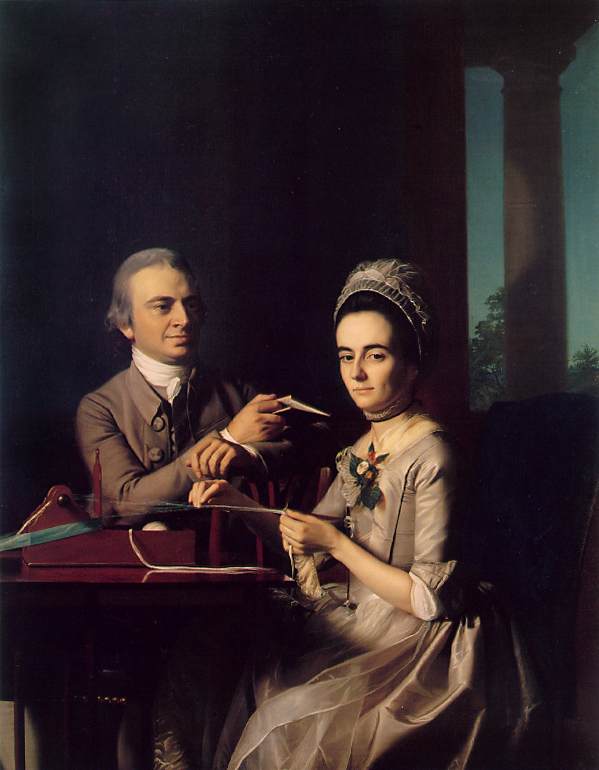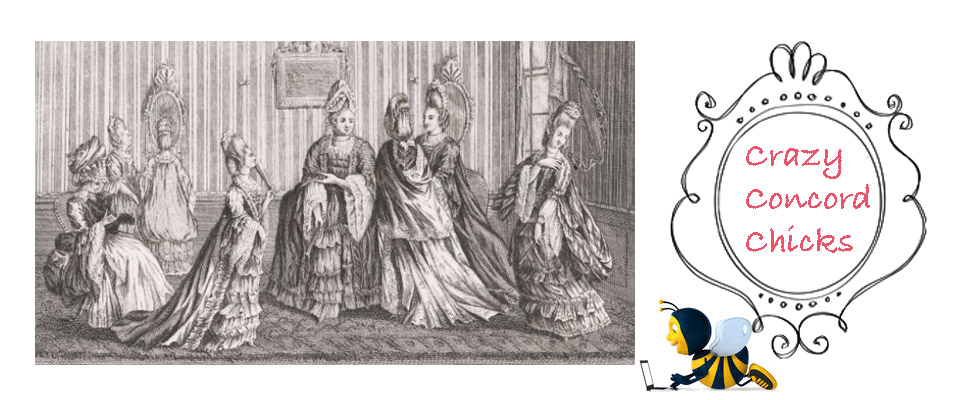- good linen lining (so many questions: what weight? what company?)
- really good quality taffeta
- and really good silk thread.
For example, I wanted to make a drawstring work bag out of linen to carry around my sewing things with me when at events, and use it as a practice piece before I made one out of silk. I went into my local fabric store that begins with a J and bought 2/3 of a yard of linen at $14.99/yd. At that price, it better be good linen--it was utter crap. I purchased Irish linen from Burnley and Trowbridge for $12/yd to make a petticoat out of and it is lovely stuff. So guess what? I totally wasted my money and have not made the work bag; I borrowed one from Mrs. Winthrop instead (thank you! again!). Even the heavier linen that came with the pocket embroidery kit I purchased was better quality!
So, I'm putting forth a plea, for newbies everywhere, asking our more experienced reenactors amongst us to tell us where to go! Where should be buy our fabrics from? Who has great linen for linings? Where can I buy a good amount of yardage of taffeta that is maybe not Scalamandre but is still quality (though for this project, I will invest in something as amazing as Scalamandre)? Where can I buy good silk thread that I can handsew with?
If vital information such as this doesn't get shared, we can all expect the newbies to never get out of their newbie-ness because of a lack of education. A poor foundation (and let's face it, the materials you use for garments are the foundation!) will cause a house to fall. So share! Open up and tell us so we can get better! The hobby needs you to!
------------------------------------------------------------------------
Hi, I'm a Sewing and Reenacting Newbie, taking part in this massive project to further my education and knowledge of the 18th century (specifically, the American Revolutionary War).
I'm not a blogging newbie, nor a newbie to history. I have my own 18th century blog chronicling my first gown, and I'm an emerging museum professional, nearly complete with the Tufts University Museum Studies certificate program. History museums are my thing, as is designing exhibits. I'm a graphic designer by trade, and that allows me to have one hand in the non-profit world, and the other in the for-profit world.
My focus for now is panned out to the max. I love material culture, so I plan on blogging about that, as well as showing the costuming, history, and blogging community what it's like to be a neophyte again (and maybe over your head just a wee bit). Expect posts on what a newbie may need, a reading list/library of books, inspiration posts, and just general discoveries. As we get closer to this part-ay, the focus will become smaller, and I hope to venture into a bit of primary source research for a persona. And, of course, the entire process of making a gown. Oh yes, the good stuff.
I hope to inspire other newbies to take the leap into handsewing, reenacting, and history. I plan on absorbing all the knowledge I can from the people I'm working with. And I am counting on you--yes, you!--to come along for the ride!
- S.R.N. (aka Miss Kristin)
------------------------------------------------------------------------
Wendy here--
I need a name, so I looked up Concord births from the early 1750s (I'll be 20 when we have our party, so I need a woman who was roughly 20 in 1773). I've narrowed it down to four names that I feel I wouldn't object to (I really didn't want to go by the name Hephzibah, for example...).
Now I'm deciding between Lydia Ball, daughter of Samuel and Percis Ball, born November 20, 1751, Rebekah Meriam, daughter of Josiah and Hannah Meriam, born September 12, 1751, Elisabeth Wheeler, daughter of Ezra and Rebekah Wheeler, born March 15, 1752, and Hannah Wesson, daughter of Stephen Wesson Junior and his wife Lydia, born June 2, 1752.
The next step is to look up the Balls, the Meriams, the Wheelers, and the Wessons. I want to know their economic statuses, where they lived, that kind of thing. Since I already have the fabric I want to use, I need one of them to be able to wear it.
------------------------------------------------------------------------
Miss Kristin checking in! On my other blog, I've started compiling a list of books that would be useful to me, and other newbie reenactors/sewers, and a great many of them will also be extremely helpful with this project. I've included a small selection that I feel will deal with exactly what we're doing as Crazy Concord Chicks. Take a look:
- Patterns of Fashion 1: Englishwomen's Dresses and Their Construction c. 1660-1860 by Janet Arnold
- Historic Dress in America 1607-1870 by Elisabeth McClellan
- What Clothes Reveal: The Language of Clothing in Colonial and Federal America by Linda Baumgarten
- Who Was I? Creating a Living History Persona by Cathy Johnson
- Costume Close-Up: Clothing Construction and Patterns 1769-1790 by Linda Baumgarten and John Watson
- Costume in Detail: Women's Dress 1730-1930 by Nancy Bradfield
- The Lady's Guide to Plain Sewing, Books I & II by a Lady
- The Workman's Guide to Tailoring Stitches & Techniques by a Tailor (book 3 of the Plain Sewing series)
- Swatches: A Guide to Choosing 21st Century Fabrics for 18th Century Clothing by Hallie Larkin
------------------------------------------------------------------------
Miss Wendy again!
I have a few hunks of fabric that really want to be gowns, one a very pretty pinky peach love birds silk damask and the other a lavender silk taffeta. I’d planned the lavender to be a sacque, so I figured it was off limits to me for the Garden Party since we’re doing very serious, very specific research for this event (it’s not enough to say “well, it’s her mother’s old gown” in this case. We want to document everything...). I’ve been having trouble finding a damask I like to copy, though, original or portrait. Then I came across this:
 This is a portrait by Jean-Honoré Fragonard, “The Love Letter.” I haven’t found out who the girl in the painting is, I’m not sure that anyone knows, actually. The portrait is in the Metropolitan Museum of Art and is dated circa 1770, which is perfect for me! The girl is pretty young and that silk is gorgeous and depending on what image of the painting I look at I think it’s light green, light blue, grey, or even lavender, so my silk will work wonderfully!
This is a portrait by Jean-Honoré Fragonard, “The Love Letter.” I haven’t found out who the girl in the painting is, I’m not sure that anyone knows, actually. The portrait is in the Metropolitan Museum of Art and is dated circa 1770, which is perfect for me! The girl is pretty young and that silk is gorgeous and depending on what image of the painting I look at I think it’s light green, light blue, grey, or even lavender, so my silk will work wonderfully!Before I can even think about making this gown, though, I’m going to need to decide what I need under it. The only shifts I have are pretty coarse, not to mention the longer seams are machine done. I also have to figure out if I need pocket hoops or hip rolls for this.
Then there’s that cap. I think I want to copy the portrait exactly (Maybe I’ll pose for a photo recreating it! I don’t think that dog is a shih tzu like my family’s dog, but I could still use our dog for it!), so I need to work out that cap and hair. I don’t know anything about doing hair other than a plain bun, so that’ll take a lot of practice (and/or help!).
The great thing about this gown is that other than that cuff, I can’t see any of the trim. That means I get to trim it however I want! I’ll have to look at other silk gowns and get ideas. Plus, until I started thinking about this specific painting, it had never occurred to me to notice how much trim is on the sleeves versus the front of the gown. Can I have more on the front than the sleeves? Or does knowing that the cuffs are pretty simple mean the front should be too? So I’ll keep looking through books and start paying attention to trim ratios.
Now that I have a look to copy, my next step is to come up with everything I’ll need to recreate it and figure out what I have to get my hands on!
------------------------------------------------------------------------
"From Zero to Overload (or, how Miss Kristin can't contain her gown excitement)"
I have suddenly been walloped by a big pink rubber mallet called Inspiration!
My dearest Mrs. Peabody, who has taken it upon herself to oversee myself and Miss Wendy's appropriate attire, has found several pieces of portraiture that have my head spinning and swimming in all things "Pretty Silk Gowns!" Adding the two Copley portraits I have been studying through correspondence with Miss Wendy, I feel as if I am on 18thc. overload! (Dear readers, this is not a bad thing!)
While I may be getting ahead of myself here, picking out a gown to reproduce before talking about basic elements, I think it relieves a large chunk of research, time, and maybe stress and anxiety, especially since it's already been "approved." Plus, having a point of inspiration already chosen leaves me time and energy to devote to other research--such as a shift, stays, stockings, on and on.
Here are the portraits I have been looking at, by Copley:
 |
 |
On the left, Mrs. Thomas Gage (Margaret Kemble), and on the left, Mr. and Mrs. Thomas Miffin (Sarah Morris). Click on the photos to be taken to their pages at the Timken Gallery of Art and the Philadelphia Museum of Art, respectively.
And, the two portraits Mrs. Peabody has picked out, one from the Connecticut Historical Society and the other from the Metropolitan Museum of Art:
 |
 |
Look these over, if you will my dear readers, and anticipate my next post: why these, and maybe, which one!

Kristin,
ReplyDeleteBe careful of potraiture! The Mrs. Thomas Gage (Margaret Kemble) painting is one of those classically inspired *i.e. she never really wore that* looks! All of the others are great choices- my vote of the selection is for the CT historical society. I love that salmon color and the simplicity is attainable.
Best,
Kristin
ReplyDeleteDitto, what Mrs Revere said. The simplicity of that gown is part of what makes it so lovely!
Hi, Vicky and Mrs. Peabody, I wish I hadn't seen these comments over a month later.
ReplyDeleteI will eventually be addressing Mrs. Gage and her Turkish costume. I have some research that points to her particular gown being not-so-fantasy as others Copley painted, as she actually has ties to Turkey. Plus, from looking at her gown compared to others, hers seems much more structured and almost closer to what we see as a Robe a la Turq. There's some thoughts/research out there that if Mrs. Gage didn't own this type of gown, her cousin that moved to NJ from what is now Turkey did, and she borrowed it from her for her portrait.
So while I appreciate the concern that I'm going to do something fictional, and that other newbies may not have any IDEA about fantasy/classically-inspired costumes in portraiture, I do and would not go ahead with a gown without first getting it "approved" I guess you could say. In fact, I was looking at Mrs. Gage's gown more for the color--and as inspiration, but not something to reproduce and wear to the garden party.